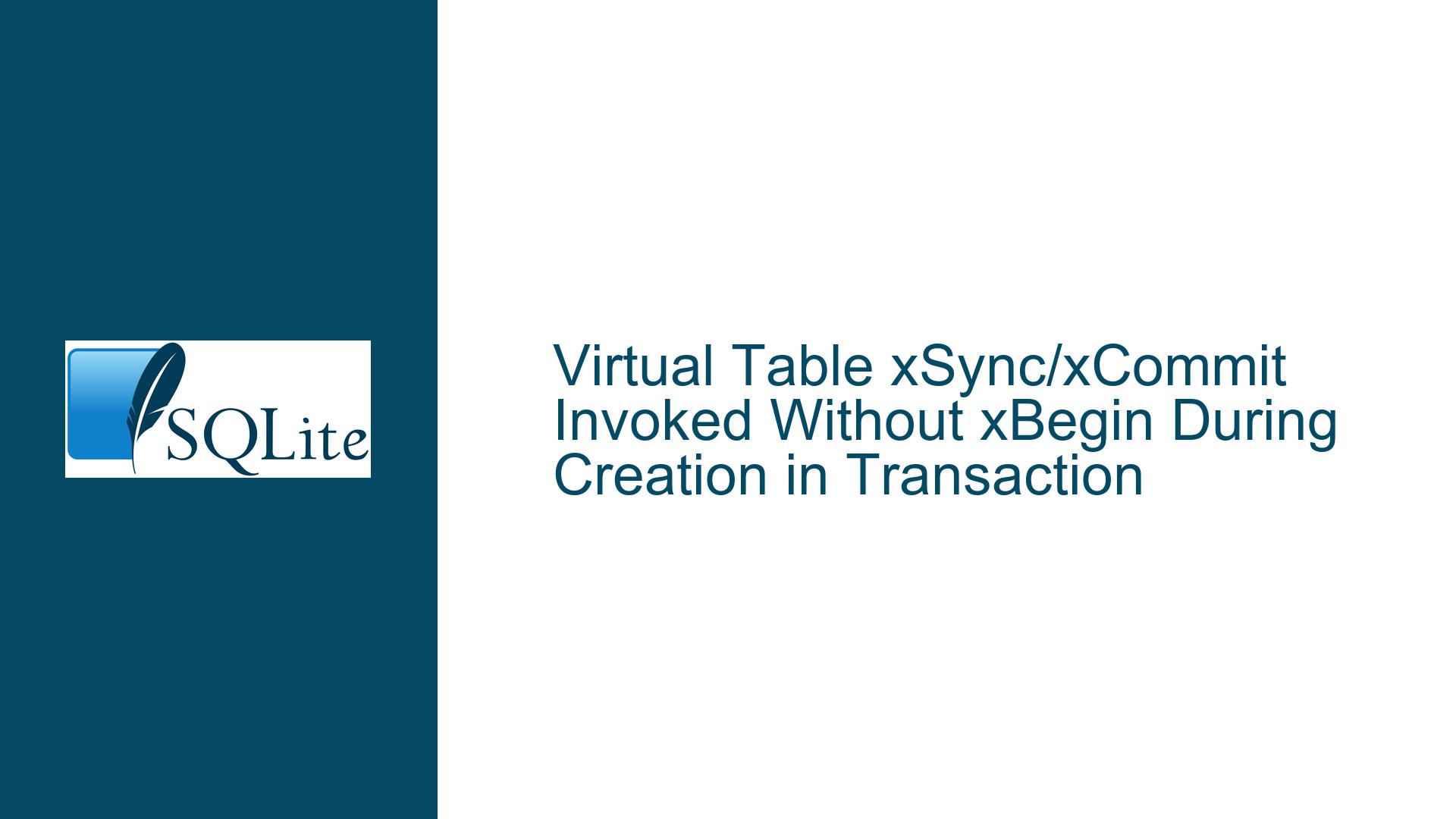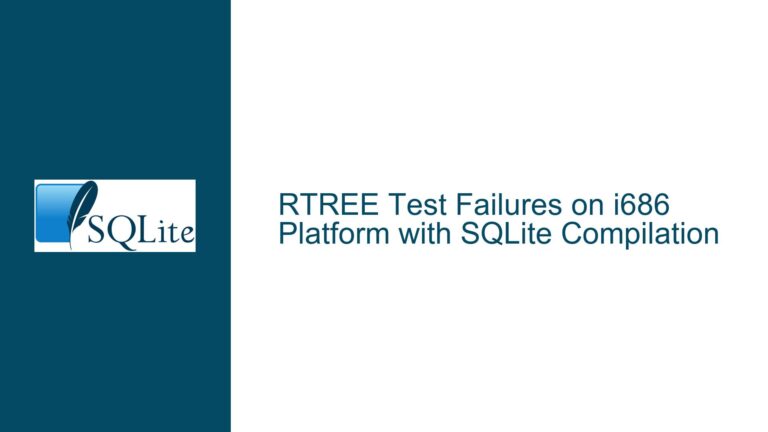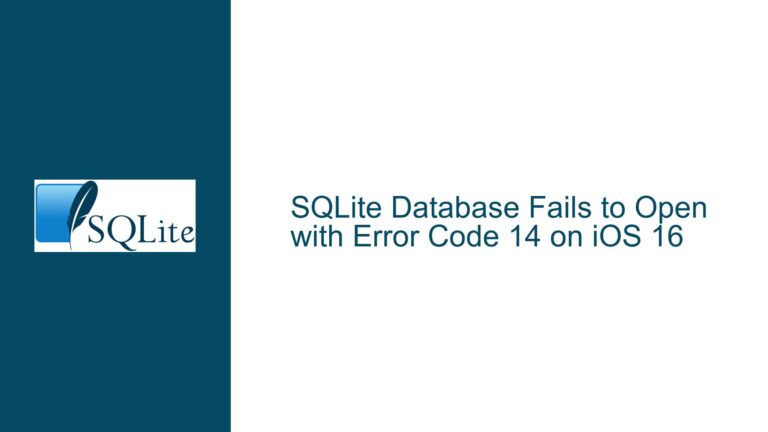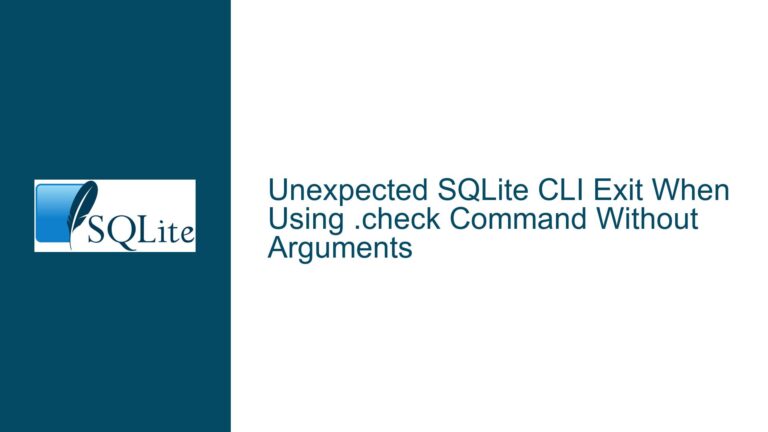Virtual Table xSync/xCommit Invoked Without xBegin During Creation in Transaction
Virtual Table Transaction Method Invocation Anomaly During DDL
The core anomaly arises when creating a virtual table within an explicit transaction in SQLite, resulting in the virtual table module’s xSync and xCommit methods being invoked without a preceding xBegin call. This violates the documented contract for virtual table transaction handling, which mandates that xSync and xCommit should only execute after xBegin initiates a transaction. The discrepancy occurs specifically during the CREATE VIRTUAL TABLE operation wrapped in a user-controlled transaction, as demonstrated by the provided test case where xSync and xCommit debug outputs fire after table creation but before the transaction’s COMMIT. This creates a risk of data integrity issues, inconsistent state management, or undefined behavior in virtual table implementations that rely on the expected transaction lifecycle.
Transaction Lifecycle Mismatch Between SQLite Core and Virtual Table Module
1. Implicit Transaction Boundaries for DDL Operations
SQLite automatically wraps Data Definition Language (DDL) operations like CREATE VIRTUAL TABLE in implicit transactions if they are not already within an explicit transaction. When a user explicitly starts a transaction with BEGIN TRANSACTION, the CREATE VIRTUAL TABLE statement executes within this context. However, the virtual table module’s transaction methods (xBegin, xSync, xCommit) are designed to manage data transactions, not schema transactions. This leads to a misalignment: the SQLite core’s schema modification logic triggers commit-phase operations (xSync, xCommit) for the virtual table’s storage without initializing the virtual table’s transaction logic via xBegin.
2. Virtual Table Module Configuration and Method Registration
The virtual table module’s xCreate method (responsible for initial table creation) and xConnect method (used for attaching to an existing table) were conflated in the test case. The diff shows templatevtabCreate directly calling templatevtabConnect, bypassing initialization steps that might properly register transaction boundaries. Furthermore, the module structure (sqlite3_module) registers xBegin, xSync, and xCommit handlers, but their invocation depends on the virtual table’s participation in write transactions. If the module does not correctly signal its transactional requirements (e.g., by not implementing xUpdate for write operations), SQLite might misapply transaction methods during schema changes.
3. Schema vs. Data Transaction Scope Ambiguity
Virtual tables often blur the line between schema and data transactions. The CREATE VIRTUAL TABLE operation itself may require the virtual table to allocate internal resources (e.g., initializing backing stores or external connections). SQLite’s transaction manager treats these as schema changes, but the virtual table module interprets them as data transactions. This mismatch causes the SQLite core to finalize the schema transaction by invoking xSync and xCommit without having called xBegin, as the schema transaction is logically separate from the virtual table’s data transaction lifecycle.
Resolving Transaction Boundary Violations in Virtual Table Implementations
Step 1: Decouple Schema and Data Transaction Handlers
Revise the virtual table module to differentiate between transactions affecting the database schema and those modifying table data. If the virtual table’s xCreate/xConnect methods allocate resources requiring transactional integrity, explicitly manage these using SQLite’s sqlite3_exec or sqlite3_prepare APIs to initiate nested transactions. For example:
static int templatevtabCreate(
sqlite3 *db,
void *pAux,
int argc, const char *const*argv,
sqlite3_vtab **ppVtab,
char **pzErr
){
sqlite3_exec(db, "SAVEPOINT vtab_init", 0, 0, 0);
// ... initialization logic ...
sqlite3_exec(db, "RELEASE vtab_init", 0, 0, 0);
return SQLITE_OK;
}
This isolates the virtual table’s setup phase within a nested transaction, preventing interference with the outer user transaction.
Step 2: Guard xSync and xCommit Against Uninitialized Transactions
Modify the xSync and xCommit implementations to validate whether a transaction was properly initiated via xBegin. Maintain internal state flags within the virtual table structure:
typedef struct templatevtab_vtab {
sqlite3_vtab base;
int transactionActive; // 0 = inactive, 1 = active
} templatevtab_vtab;
static int templatevtabBegin(sqlite3_vtab* tab) {
templatevtab_vtab* pVtab = (templatevtab_vtab*)tab;
pVtab->transactionActive = 1;
fprintf(stderr, "xBegin called\n");
return SQLITE_OK;
}
static int templatevtabSync(sqlite3_vtab* tab) {
templatevtab_vtab* pVtab = (templatevtab_vtab*)tab;
if (!pVtab->transactionActive) {
return SQLITE_OK; // No-op if no transaction
}
fprintf(stderr, "xSync called\n");
return SQLITE_OK;
}
static int templatevtabCommit(sqlite3_vtab* tab) {
templatevtab_vtab* pVtab = (templatevtab_vtab*)tab;
if (!pVtab->transactionActive) {
return SQLITE_OK; // No-op if no transaction
}
fprintf(stderr, "xCommit called\n");
pVtab->transactionActive = 0;
return SQLITE_OK;
}
This ensures xSync and xCommit only execute when a transaction was explicitly started via xBegin, aligning with SQLite’s expectations.
Step 3: Explicitly Declare Transaction Requirements in the Virtual Table Module
If the virtual table does not support write operations, set the SQLITE_VTAB_DIRECTONLY flag during module registration and omit the xUpdate method. This signals to SQLite that the virtual table is read-only, preventing it from invoking transaction methods during schema changes. Alternatively, if the virtual table does handle writes, ensure that xBegin is called before any xSync/xCommit by strictly associating transaction lifecycles with data modification operations. Augment the xBestIndex method to include transaction constraints in query planning, ensuring the SQLite optimizer understands when transactional methods are required.
Final Adjustment: Testing with Explicit and Implicit Transactions
After implementing the above fixes, validate the virtual table’s behavior under multiple scenarios:
- Explicit Transaction with DDL:
BEGIN; CREATE VIRTUAL TABLE t USING templatevtab(); COMMIT;Verify that
xBegin,xSync, andxCommitare called in sequence. - Implicit Transaction (Autocommit):
CREATE VIRTUAL TABLE t USING templatevtab();Confirm that transaction methods are not invoked unless the virtual table’s initialization logic explicitly starts a transaction.
- Nested Transactions:
BEGIN; SAVEPOINT sp1; CREATE VIRTUAL TABLE t USING templatevtab(); RELEASE sp1; COMMIT;Ensure transaction state is correctly managed across nested contexts.
By rigorously decoupling schema and data transactions, guarding against uninitialized transaction states, and clarifying the virtual table’s transactional capabilities, developers can align their modules with SQLite’s expectations and prevent violations of the documented transaction lifecycle.






